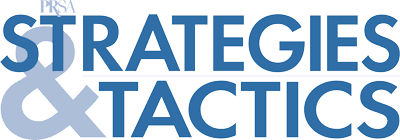From Burnout to Breakthrough: 3 Strategies for PR Pros
By Katie Neal
November-December 2025
“Why do you give your best to work and leave us with the leftovers?”
I’ll never forget when my husband’s question punched me in the gut.
I was leading the PR team at my alma mater at the time, a job that I simultaneously loved and stressed over. No effort of mine could ever create an environment where everything went smoothly on a college campus. Writing this today, 10 years later, it feels foolish (and even a little arrogant) to think that was ever possible — or that it was my responsibility.
His words struck me because they were true. My priorities were out of alignment, leaving my family caught in the wake of whatever issue or crisis I was managing at the time.
Even though I had a job I loved, I was burned out. Things had to change. I had to change.
The PR pressure cooker
Fast-forward to this September. Now, as a certified executive coach who helps communications professionals navigate their own personal and professional crossroads, I had the privilege of presenting on perfectionism, imposter syndrome and burnout at the PRSA East Central District Conference (PRSA-ECD).
Heads nodded as I shared some powerful stats:
- 50% of PR pros have considered quitting due to burnout.
- 64% experience extreme stress or burnout.
- 96% struggle to disconnect from work.
The stakes for burnout are high: declining performance and creativity, career stagnation, strained relationships, lower fulfillment, missed opportunities and both mental and physical health issues.
The challenges are many and the pace of change in our industry is relentless. The political climate and economic uncertainty have turned up the tension. Budgets are tightening, jobs feel precarious and delivering sound PR counsel is more complex than ever.
Many of these things are outside of our control. And just like my experience at my alma mater, many PR pros respond in kind by trying to control more than what’s possible and end up burning themselves out in the process.
If this resonates, then consider these three ways to turn your potential breaking point into a turning point.
First, ask yourself some tough questions.
As PR professionals, one of our superpowers is the ability to see what’s coming around the corner. Our experience in crisis communications has trained us to anticipate the worst-case scenario. But how often do we ask ourselves the flip side: “What’s the best thing that could happen?”
Outside of crisis drills, most of our time should be spent considering the most likely outcome. This more balanced view prevents us from dwelling on doomsday scenarios and frees up mental energy, reducing the frequency and intensity of burnout.
And while I’ve never seen a study quantifying perfectionism among PR pros, I’d wager the rates are higher than average. The very qualities rewarded early in our careers — high standards, long hours, meticulous attention to detail, persistence — are also the ones that fuel burnout.
Instead of holding yourself to impossible standards, ask: “How are these perfectionistic tendencies serving me? What does ‘good enough’ look like here?” Getting honest about your motivations is an important step toward freeing up the mental capacity to break through, rather than break down.
Silence your inner critic.
Most of my clients who struggle with burnout are also relentlessly self-critical. Rationally, they know they’re good at their jobs, but they keep moving the goalposts and, in doing so, perpetuate burnout culture.
When you realize your inner critic’s voice is louder than it needs to be, try one of these strategies:
- Create an environment of acceptance. What would it take to move from “I can do this” to “I truly have something of value to offer?”
- Practice self-compassion. Mistakes are inevitable. Embrace a growth mindset and appreciate them as learning moments.
- Reframe negative self-talk. At PRSA-ECD, I asked attendees to take an accomplishment they had downplayed and rewrite it as a headline they’d love to see for a client. It’s a meaningful perspective shift.
- Talk to yourself like you would a colleague. Offer yourself the same grace and kindness you extend to others.
Set boundaries and say no.
Recently, I was invited to serve on the board of an organization I care deeply about. My answer? “I’d like to, but not this year.”
I considered my business’s growth, my existing commitments, and, yes, that question from my husband a decade ago. The best choice was to wait.
Was it hard? Absolutely. Did I disappoint some people? Probably. But always saying yes, always being available, and always being the last one online isn’t a strength. It’s a lack of boundaries.
Some of my favorite techniques for protecting time and sanity include:
- Recognizing what must be done now versus what can wait
- Time-blocking to protect focus
- Training others so you can delegate effectively
- Communicating after-hours expectations with colleagues and clients
As Brené Brown reminds us, “Clear is kind.”
More than leftovers
As you set goals for the new year, remember that burnout isn’t a badge of honor, and it certainly isn’t sustainable. By asking better questions, quieting your inner critic and setting clearer boundaries, you can reclaim much of the energy and creativity that drew you to PR in the first place.
This isn’t just about individual well-being — it’s about the future of our profession. The work we do requires clarity, resilience and perspective. When we protect our capacity to think, create and connect, we show up better for our clients, our colleagues and our communities.
After all, the people and organizations we care about deserve more than our scraps — and so do we.



